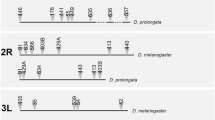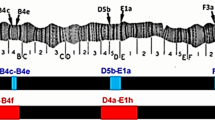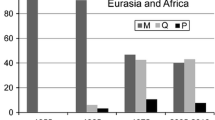Abstract
In situ hybridization on polytene chromosomes of Drosophila melanogaster was used to compare the insertion patterns of copia and mdgl transposable elements on chromosome 2 in male gametes sampled by two different methods: (i) by crossing the males tested with females from a highly inbred line with known copia and mdgl insertion profiles; (ii) by crossing the same males with females from a marked strain, and analysing the resulting homozygous chromosomes. Crossing of the males with the inbred line led to homogeneous insertion profiles for both the copia and mdgl elements in larvae, thus giving an accurate estimation of the patterns in the two gamete classes of each male. Crossing with the marked strain led, however, to heterogeneity in insertion patterns of the copia transposable element, while no significant polymorphism was observed for mdgl. The use of balancer chromosomes is thus not an adequate way of inferring transposable element insertion patterns of Drosophila males, at least for the copia element. This technique could, however, be powerful for investigating the control of movements of this element.
Similar content being viewed by others
References
Biemont C (1992) Population genetics of transposable elements. A drosophila point of view. Genetica 86:67–84
Biemont C, Gautier C (1988) Localisation polymorphism of mdg1, copia, I and P elements in genomes of Drosophila melanogaster from data of inbred lines. Heredity 60:335–346
Bregliano JC, Kidwell MG (1983) Hybrid dysgenesis determinants. In: Shapiro J (ed) Mobile genetic elements. Academic Press, New York, pp 363–410
Bregliano JC, Picard G, Bucheton A, Pélisson A, Lavige JM, L'Héritier P (1981) Hybrid dysgenesis in Drosophila melanogaster. Science 207:606–611
Charlesworth B, Lapid A (1992) The distribution of transposable elements within and between chromosomes in a population of D. melanogaster. Inferences on the nature of selection against elements. Genet Res 60:115–130
Dobzhansky T, Bcesiger E (1968) Essais sur l'evolution. Masson et Cie, Paris, p 182
Dunsmuir P, Brorein WJ, Simon MA, Rubin GM (1980) Insertion of the Drosophila transposable element copia generates a 5 base pair duplication. Cell 21:575–579
Eanes WF, Wesley C, Hey J, Houle D, Ajioka J (1988) The fitness consequences of P element insertion in Drosophila melanogaster. Genet Res 52:17–26
Eggleston WB, Johnson-Schlitz DM, Engels WR (1988) P-M hybrid dysgenesis does not mobilize other transposable element families in Drosophila melanogaster. Nature 331:368–370
Georgiev PG, Kiselev SL, Simonova OB, Gerasimova TI (1990) A novel transposition system in Drosophila melanogaster depending on the stalker mobile genetic element. EMBO J 9:2037–2044
Harada K, Yukuhiro K, Mukai T (1990) Transposition rates of movable genetic elements in Drosophila melanogaster. Proc Natl Acad Sci USA 87:3248–3252
Ilyin YV, Chmeliauskaite VG, Georgiev GP (1980) Double stranded sequences in RNA of Drosophila melanogaster: relation to mobile dispersed genes. Nucleic Acids Res 8:3439–3457
Kidwell MG (1983) Intraspecific hybrid sterility. In: Ashburner M, Carson HL, Thompson JW (eds) Genetics and biology of Drosophila, vol 3C. Academic Press, London, pp 125–153
Kidwell MG, Kidwell JF (1976) Selection for male recombination induction in Drosophila melanogaster. Genetics 84:33–353
Kidwell MG, Kidwell JF, Sved JA (1977) Hybrid dysgenesis in Drosophila melanogaster: a syndrome of aberrant traits including mutation, sterility and male recombination. Genetics 86:813–833
Levis R, Dunsmuir P, Rubin GM (1980) Terminal repeats of the Drosophila transposable element copia: nucleotide sequence and genome organization. Cell 211:581–585
Lewis EB, Mislove RF (1953) New mutants report. Dros Inf Serv 27:57–58
Lindsley DL, Grell EH (1967) Genetic variations of Drosophila melanogaster. Carnegie Institution of Washington, publication no. 627
McIntyre RT, Wright TRF (1966) Recombination in FM4/+;SM1/+;Ubx130/+ heterozygous. Dros Inf Serv 41:141–143
Montgomery EA, Charlesworth B, Langley CH (1987) A test for the role of natural selection in the stabilization of transposable elements copy number in a population of D. melanogaster. Genet Res 49:31–41
Pasyukova EG, Belyaeva ES, Ilyinskaya LE, Gvozdev VA (1988) Outcross-dependent transpositions of copia like mobile genetic elements in chromosomes of an inbred Drosophila melanogaster stock. Mol Gen Genet 212:281–286
Pasyukova EG, Nuzhdin SV (1993) Doc and copia instability in an isogenic Drosophila melanogaster stock. Mol Gen Genet 240:302–306
Slatko BE (1978) Evidence for newly induced genetic activity responsible for male recombination induction in Drosophila melanogaster. Genetics 90:105–124
Tchurikov NA, Ilyin YV, Skryabin KG, Ananiev EV, Bayev AA, Lyubomirskaya NV, Georgiev GP (1981) General properties of mobile dispersed genetic elements in Drosophila. Cold Spring Harbor Symp Quant Biol 45:655–665
Voelker RA (1974) The genetics and cytology of a mutator factor in Drosophila melanogaster. Mutat Res 22:265–276
Waddle FR, Oster II (1974) Autosomal recombination in males of Drosophila melanogaster caused by transmissible factor. J Genet 61:177–183
Woodruff RC, Thompson JN, Lyman RF (1979) Intraspecific hybridization and the release of mutator activity. Nature 278:277–279
Woodruff RC, Blount JL, Thompson JN (1987) Hybrid dysgenesis in Drosophila melanogaster is not a general release mechanism for DNA transpositions. Science 237:1206–1207
Author information
Authors and Affiliations
Additional information
Communicated by D. Finnegan
Rights and permissions
About this article
Cite this article
Garcia Guerreiro, M.P., Biémont, C. Changes in the chromosomal insertion pattern of the copia element during the process of making chromosomes homozygous in Drosophila melanogaster . Molec. Gen. Genet. 246, 206–211 (1995). https://doi.org/10.1007/BF00294683
Received:
Accepted:
Issue Date:
DOI: https://doi.org/10.1007/BF00294683




